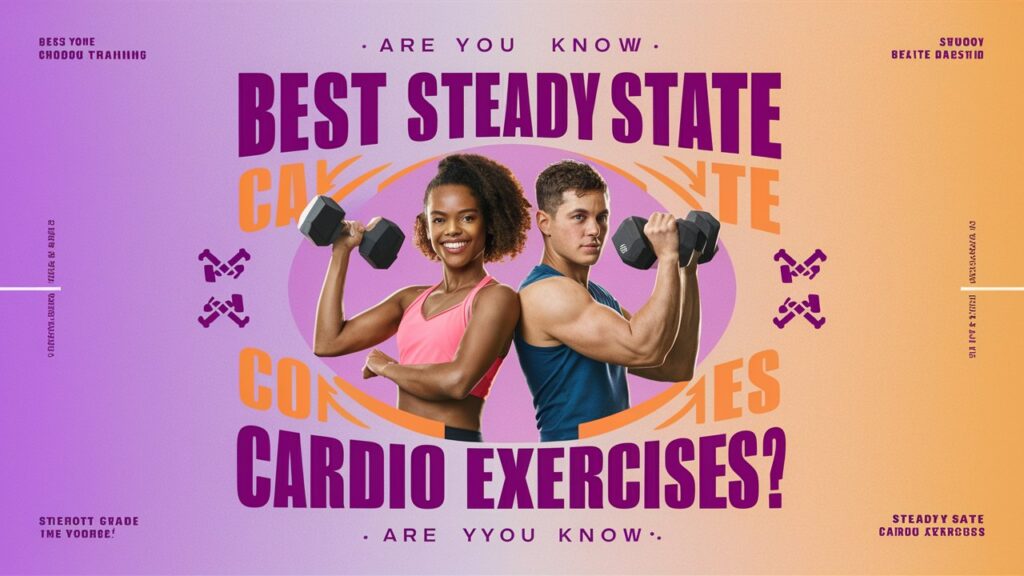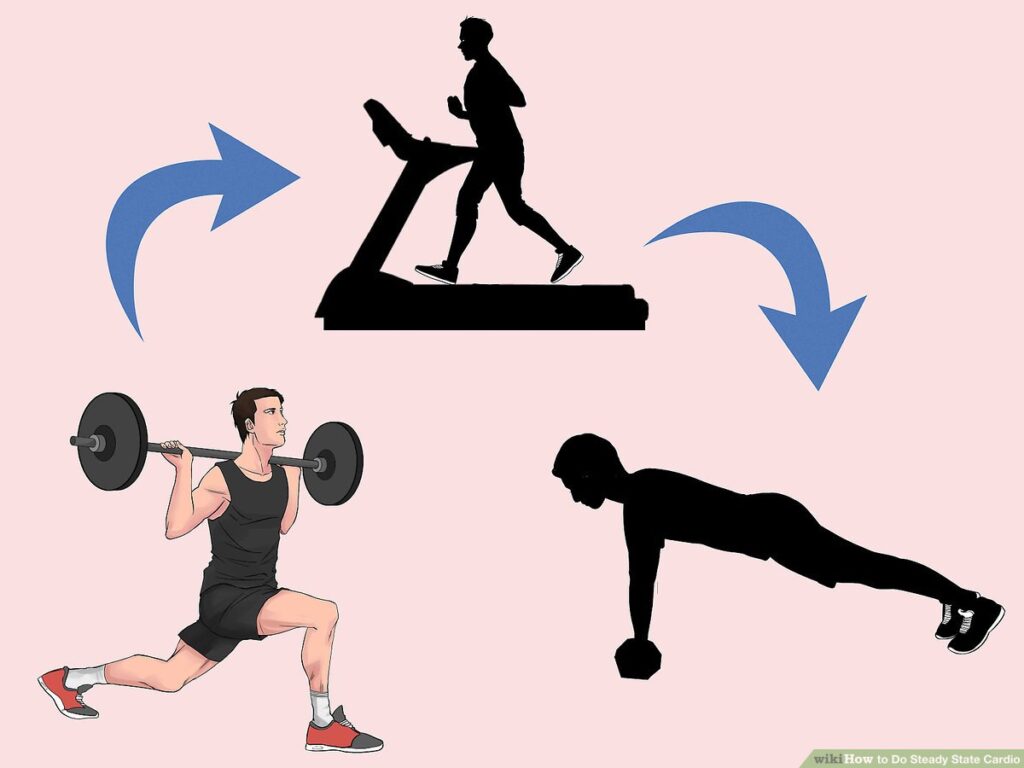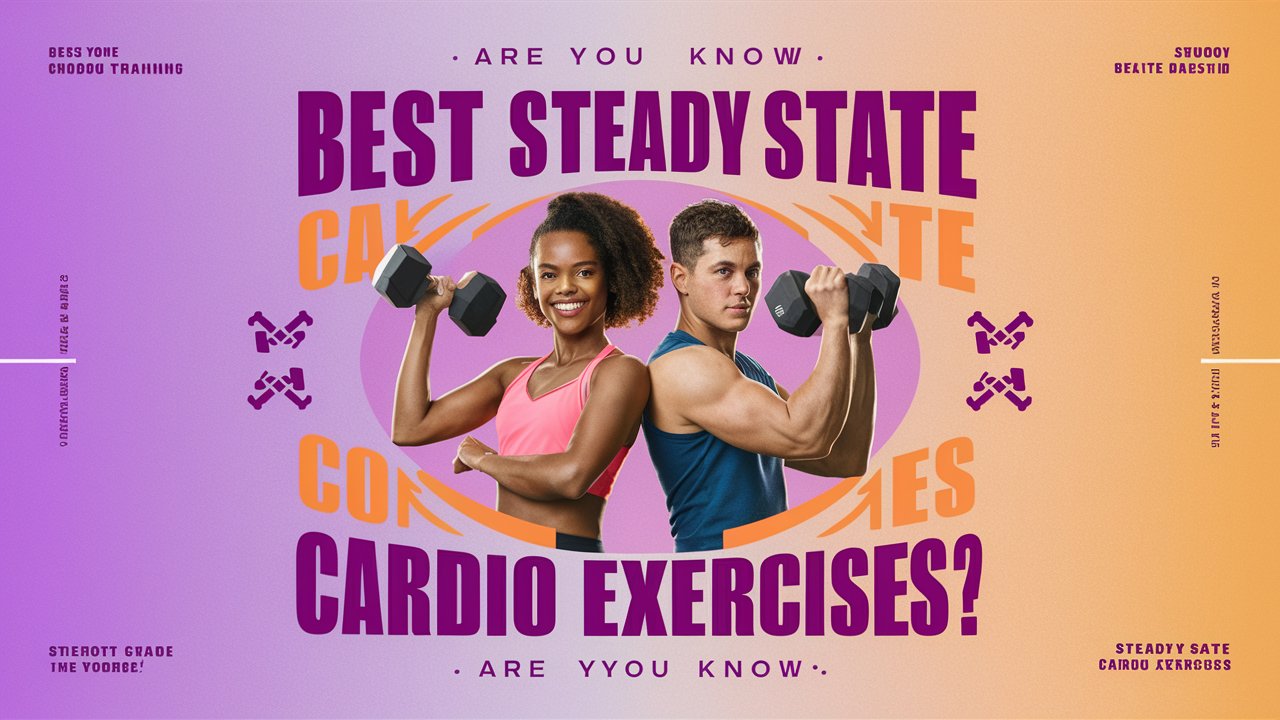Steady State Cardio Exercises for Weight Loss:

Steady state cardio, often abbreviated as SSC, refers to any aerobic activity performed at a consistent, moderate intensity for an extended period. This form of exercise maintains a steady heart rate and can include activities like walking, running, cycling, and swimming. Unlike high-intensity interval training (HIIT), which involves short bursts of intense activity followed by rest periods, steady state cardio is continuous and maintains a uniform effort level.
Table of Contents
It doesn’t matter if you’re a certified gym rat or just getting back into fitness, trying to lose weight or looking to improve sports performance, steady state cardio should be at the center of your routine.
So what is steady state cardio and why does it matter? Keep reading because I’m going to share the ultimate guide to everything steady state cardio, including how to get into the steady state zone, what exercises will get you there, and how often you should do it.
Steady state cardio is a staple in many fitness routines due to its accessibility and numerous health benefits. Whether you’re aiming to improve your cardiovascular health, manage weight, or boost mental well-being, steady state cardio offers a reliable and effective workout option.
Types and Categories
Types of Steady State Cardio Exercises
- Walking: An excellent low-impact exercise suitable for all fitness levels.
- Running: A popular choice for those looking to burn calories and improve cardiovascular health.
- Cycling: Can be done outdoors or on a stationary bike, offering a great leg workout.
- Swimming: Provides a full-body workout and is gentle on the joints.
- Elliptical Training: A low-impact option that simulates walking or running.
Categories Based on Intensity
- Low-Intensity Steady State (LISS): Activities that keep your heart rate at 50-65% of your maximum heart rate, such as walking or light cycling.
- Moderate-Intensity Steady State (MISS): Exercises that elevate your heart rate to 65-75% of your maximum, including brisk walking or moderate cycling.
- High-Intensity Steady State (HISS): Workouts that push your heart rate to 75-85% of your maximum, like running or vigorous cycling.
Benefits of Steady State Cardio
Cardiovascular Health

Engaging in steady state cardio regularly strengthens the heart and improves circulation, reducing the risk of heart disease and stroke. It helps lower blood pressure and enhances the efficiency of the cardiovascular system.
Weight Loss and Management
Steady state cardio is an effective way to burn calories, aiding in weight loss and maintenance. Consistent exercise can help create a calorie deficit, which is essential for weight loss.
Mental Health Benefits
Regular cardio exercise releases endorphins, known as “feel-good” hormones, which can alleviate stress, anxiety, and depression. It also promotes better sleep and boosts overall mood.
Improved Endurance
By maintaining a steady pace for an extended period, steady state cardio improves aerobic capacity and stamina, allowing you to perform daily activities with less fatigue.
Muscle Preservation
Unlike HIIT, which can sometimes lead to muscle loss due to its high intensity, steady state cardio helps preserve muscle mass while burning fat, especially when combined with strength training.
EXAMPLES OF STEADY STATE CARDIO

There are so many great modalities you can use with your steady state cardio, as long as you’re doing them at a lower intensity:
- Cycling
- Elliptical
- Stairmaster
- Fan bike
- Dance class
- Rower
- Running
The key with any of these is making sure your heart rate is not constantly going up and down. In a few sections, I’ll get into figuring out what heart rates you should be training at. Just know it’s called steady state for a reason.
DOES WALKING COUNT AS STEADY STATE CARDIO?
Walking is a great way to get your steady state cardio in as long as you’re still in the beginning stages of your cardiovascular journey. For example, if it’s been at least 6-12 months since you’ve exercised, then yes, walking will be a perfect modality to use. However, if you’ve already been doing steady state cardio training for a while, your heart rate won’t climb high enough during walking. Remember, the only rule you can’t break with steady state cardio, is that you must be in your Zone 2 range.
If you have access to a treadmill that allows you to increase not only the speed, but the incline as well, then this can be great choice to get the intensity up if needed. When transitioning to an incline, start to increase the grade conservatively, and see how not only heart rate reacts, but your ankles and knees as well.
One more thing to consider when using a treadmill is to not hold onto the railings if possible. Holding on lowers the intensity of the exercise and it changes how you walk. When you walk, your arms are meant to swing front to back and your torso and pelvis are meant to rotate. Holding on prevents this from occurring.
THE BEST FORM OF STEADY STATE CARDIO
I get this question a lot, and I get it for anything new I’m teaching someone. I hate to burst your bubble but there is no “best” form of steady state cardio.
Drawbacks and Limitations
Risk of Overuse Injuries
Repetitive motions involved in steady state cardio can lead to overuse injuries, such as shin splints or tendonitis, particularly if proper form and technique are not maintained.
Plateaus in Weight Loss
The body can adapt to steady state cardio over time, leading to a plateau in weight loss. Mixing up the routine and incorporating other forms of exercise can help overcome this hurdle.
Time Consumption
Steady state cardio often requires a significant time commitment, especially compared to HIIT, which can be completed in shorter durations with similar benefits.
Comparing Steady State Cardio with Other Cardio Forms
Steady State Cardio vs. High-Intensity Interval Training (HIIT)
While steady state cardio involves continuous, moderate effort, HIIT alternates between high-intensity bursts and rest periods. HIIT is known for its efficiency in burning calories in a short amount of time, but it can be more physically demanding and is not suitable for everyone.
Steady State Cardio vs. Circuit Training
Circuit training combines cardio and strength exercises in a sequence with minimal rest between sets. It offers a full-body workout and can be more varied and engaging than steady state cardio. However, steady state cardio is often easier to sustain for longer periods and may be less intimidating for beginners.
How to Incorporate Steady State Cardio into Your Routine
Beginner’s Guide
Start with low-intensity activities like walking or light cycling. Aim for 20-30 minutes per session, gradually increasing the duration and intensity as your fitness improves.
Intermediate and Advanced Strategies
For those with a higher fitness level, incorporate moderate to high-intensity steady state cardio sessions, such as running or vigorous cycling. Aim for 45-60 minutes per session, focusing on maintaining a consistent effort throughout.
Sample Weekly Workout Plans
- Beginner: 3-4 days of low-intensity cardio (30 minutes each), plus 2 days of strength training.
- Intermediate: 4-5 days of moderate-intensity cardio (45 minutes each), plus 2-3 days of strength training.
- Advanced: 5-6 days of high-intensity cardio (60 minutes each), plus 3 days of strength training.
Tips for Maximizing Effectiveness

Importance of Consistency
Consistency is key to reaping the benefits of steady state cardio. Establish a regular routine and stick to it, gradually increasing the intensity and duration of your workouts.
Integrating with Strength Training
Combining steady state cardio with strength training can enhance overall fitness. Aim to balance both forms of exercise to prevent muscle loss and improve metabolic rate.
Monitoring Heart Rate
Use a heart rate monitor to ensure you are working within your target heart rate zone. This helps optimize the effectiveness of your workouts and prevents overexertion.
Proper Nutrition and Hydration
Fuel your body with a balanced diet rich in carbohydrates, proteins, and healthy fats. Stay hydrated before, during, and after workouts to maintain performance and aid recovery.
Rest and Recovery
Allow your body to recover by incorporating rest days into your routine. Adequate sleep and proper recovery techniques, such as stretching and foam rolling, are essential for preventing injuries and improving performance.
Common Myths and Misconceptions
“Steady State Cardio is Ineffective for Weight Loss”
Steady state cardio can be effective for weight loss when combined with a balanced diet and consistent routine. It’s a sustainable way to burn calories and manage weight over time.
“You Must Do Hours of Cardio to See Results”
Quality over quantity is important. Effective cardio sessions can be as short as 30 minutes if done consistently and at the right intensity.
“Steady State Cardio is Boring and Monotonous”
Varying your workouts, changing your environment, and incorporating different types of steady state exercises can keep your routine interesting and enjoyable.
Success Stories and Personal Experiences
Testimonials from Fitness Enthusiasts
Many individuals have experienced significant health improvements through steady state cardio. Testimonials highlight weight loss, improved endurance, and enhanced mental well-being.
Case Studies of Weight Loss Success
Detailed case studies demonstrate how steady state cardio, combined with a healthy diet and lifestyle changes, has led to substantial weight loss and health benefits.
Stories of Improved Cardiovascular Health
Real-life stories showcase how consistent steady state cardio has helped individuals lower blood pressure, improve cholesterol levels, and reduce the risk of heart disease.
Expert Insights
Quotes from Fitness Trainers
“Steady state cardio is a fantastic way to build a strong aerobic base. It’s accessible to everyone and can be tailored to any fitness level.” – Jane Doe, Certified Personal Trainer
Advice from Medical Professionals
“Regular steady state cardio can significantly reduce the risk of chronic diseases, improve mental health, and enhance overall quality of life.” – Dr. John Smith, Cardiologist
Conclusion
Steady state cardio offers a wealth of benefits for individuals of all fitness levels. By incorporating various forms of steady state exercise into your routine, you can improve cardiovascular health, manage weight, and boost mental well-being. Remember to balance your workouts with strength training, monitor your heart rate, and maintain consistency for the best results. If you’re new to steady state cardio, start slow and gradually increase the intensity and duration of your sessions. For those more advanced, challenge yourself with higher intensity workouts and longer durations. With dedication and proper guidance, steady state cardio can be a valuable and enjoyable part of your fitness journey.
- Also Read :
- Strength Training for Women over 50: Empowering Workouts
- Bodyweight Strength Training: No Equipment Needed
- Ultimate Guide to Strength Training Workouts
- What is Functional Strength Training
- 10 Yoga Poses for Neck Pain
FAQs about Steady State Cardio:
What is Steady State Cardio?
Steady state cardio is a form of aerobic exercise performed at a consistent, moderate intensity for an extended period. It involves maintaining a steady heart rate and effort level throughout the workout.
How does steady state cardio differ from other forms of cardio?
Unlike high-intensity interval training (HIIT), which involves alternating periods of intense activity and rest, steady state cardio maintains a continuous, moderate effort. This makes it less intense but more sustainable over longer periods.
What are the benefits of steady state cardio?
The benefits include improved cardiovascular health, weight loss and management, enhanced mental health, increased endurance, and muscle preservation.
What are some common types of steady state cardio exercises?
Common types include walking, running, cycling, swimming, and using an elliptical machine.





